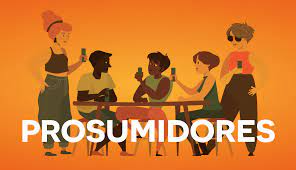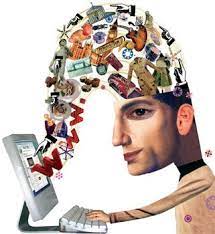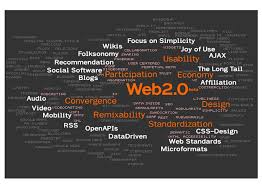Prosumers

by Adalid Contreras Baspineiro *
The citizen insurgency in social networks has caused one of the most striking modifications in contemporary communicational cartography, recomposing, by invasion, the relationship between a message-emitting pole, traditionally concentrated in an all-embracing monopoly power composed of certain elites, media and / or or the State exercising persuasive transmissive roles, and some supposedly passive citizenships situated at the reception pole.
Curiously, the triggering factor for this recomposition is not a communicational element, but basically a technological one, which turns into a sociocultural dynamic where new generations are born and socialize in other ways of relating to themselves, their surroundings and the world. The incorporation of the World Wide Web world in communication processes has changed the patterns of media consumption, but also the accesses, opening its borders and, in a certain way, has decentered the spaces of discursive production, as well as the nature of these spaces.

New patterns of media consumption
Since the incorporation of the web, the new natives on the planet are digital. Previous generations socialized with the press, radio and television, fulfilling the roles of conceptually passive and actually active receptors, with the ability to redefine messages. Some experiences, such as popular radio, have already transgressed this scheme with the forcefulness of participation, dialogue and inclusive society projects. The contemporary experience, which raises access and participation is another, different, both in the forms of consumption and in those of production.
A first element that is modified in consumption is its dismemberment by the technical facilities of individualized consumption, especially with the cell phone and of course, also with tablets and computers. We are experiencing a process, on the one hand of relocation of the experiences of collective reception, and on the other of transition towards forms of individual consumption. Radio or television, operating as icons of the family reunion, are increasingly distant figures or focused on special events such as a good football game or important news. In previous years, collective consumption connoted a collective vested interest and a collective dialogue on a shared theme.
This practice is in the process of being divided by the characteristics of individualized access, in relation to or with interests, or tastes, or moods, or requirements, or urgencies, or habits, also individualized. An antecedent of these procedures is found in zapping, which allows watching television without the predominance of the medium, but with the selective and decision-making possibilities of the consumer, in a diversified sea of cable and satellite offers. This practice overcomes a previous situation of confinement in a channel, a schedule, a program. It is true that these are practices that are still in force, especially in the consumption of news programs and soap operas, as well as it is also true that, in times of crisis, traditional media recover their audiences because they enjoy greater credibility. As in any rearrangement process, communicational practices operate juxtaposed.
In contemporary consumption, as Carlos Scolari says "the new generations tend to see different things, in different media and with different consumption modalities (live, streaming, downloads, etc.)". And this is how this world is today, where it is no longer the medium that unites the individualities, but a narrative, a story that can circulate on YouTube, or WhatsApp, or a blog, or can be downloaded to see it on the computer, or get the link to see it in image, or listen to it in audio, or read it, with the possibility of repeating them if you want, or stopping them midway and rewinding them.
In any case, the consumer can accommodate the offer according to their needs, or interests, or moods and, in addition, circulate it through other various means, because it may seem that the story is important, or funny, or even with the illusion of showing a scoop. That is, it receives and also (re) sends and (re) produces.

Other patterns of discursive production
But perhaps the most striking recomposition that is taking place in the field of consumption is to have also opened mixed production spaces: fragmented and shared, both by traditional, mass media, which are being called predigital media, as well as in the post-digital that operate in the decentralized logic of digital social networks.
This is the place where prosumers are born, developing remixing (remixing) and / or post-production processes that no longer revolve only in the resignification of imaginaries, but also in the production of new narratives, either as arrangements, arrangements, retouching or reconfigurations of already established messages, or also with other discursive creations, or new characters or stories.
The term prosumers was proposed by Alvin Toffler beginning in the eighties of the last century, to highlight the union of functions between producers and consumers. In its contemporary sense, it is characterized by forging forms of exposition of narratives through crossmedia and transmedia systems, which are not explained only in technological facilities, but basically in a communicative attitude that leads to the daily development, as an established cultural form, practices of appropriation, modification and recirculation of the messages to which their own meanings are given. In other words, the consumer is incorporated into the narratives (re) constructing them.
Crossmedia, as its name implies in English, means to cross (cross) the media (media). It is about coherently presenting the same story through various media, supports, channels and platforms that reinforce each other, making a unity as a whole. Its immediate reference is multimedia systems, from which it differs because these were based on interactivity between different media working on the same message, instead now the relationship is based on the integrated convergence that digital platforms allow.
For its part, transmedia is characterized by the fact that it displays a narrative in various media, channels, platforms, and formats, each acting separately, with its own languages and audiences, without the need to articulate between them to make sense of a story. Each one counts it independently in their own way. Under these conditions, it is no longer the communication offer that gives convergence to a story told in different languages and in different media, it is the consumers who articulate them, sometimes accessing a comic, sometimes an opinion article, or a video. , or a podcast, or with dolls, or radio soap operas. There are convergences between the discursive production of the classic cultural industries with their structure of journalists and deontological codes, and the discursive production of users, who are not governed by norms and occupy social networks protected by freedom of expression.
We highlight five features that characterize the functioning of digital social networks: self-assertion, inorganic voluntarism, unscrewing, social reassembly and communicational entropy. The guideline for "self-affirmation" is given by Manuel Castells, when he conceptualizes as self-communication the unlimited capacity to receive, reproduce and generate messages as bursts of multidiscursive creations, reflecting beyond the technological possibility, the compulsive need of cybernauts for expressing and becoming protagonists, initiating with identity or anonymously cumulative creations of memes, videos, posters, photographs, songs, graffiti, infographics and articles that circulate and are reproduced at the same speed as events.

The networks operate free to forms of autonomous functioning that become the bases of the explosions of “inorganic voluntarism”, which, when operating without rules or protocols, are manufacturers of reiterations, intoxication and dispersal of messages in an endless maelstrom of information. In this environment, the "unscrewing" is the displacement of the traditional forms of communication towards others of "almost interaction", defined thus by John Thompson, because they do not obey the canons of interpersonal or massive reciprocities, but rather develop exchange processes symbolic-digital in virtual communities.
Beyond this feature, social networks have an immense potential for mobilization when their cybercommunaries decide to weave and act in a network and not just be part of a network. In traditional practices, the sit-in, the blockade and the march are expressions of multitudinous presences that articulate individualities in a block of force. With social networks, tweets or whatsappazos multiply by hundreds of thousands the number of participants seeking to make a trend. Following Bruno Latour, we call this feature “social reassembly”, the articulation of individualities in a functioning of community complementarities.
In any case, viralizing messages or creating a trend are processes that are not exempt from a sense of "communication entropy", or loss of energy and communication, because it tends to be confused with an effect of self-indulgent illusion by which each cyber-community believes " the ”author of results, which are undoubtedly explained by a multiplicity of other factors, which do not remain at the level of emotions.
Closing this point, let us underline that new technologies have established not only new forms of consumption, but also other forms of production that, although based on the technological conditions provided by algorithms, are already forms of communication that have become cultural habits and guidelines. especially in the new generations that are already born into a digitized world.
This phenomenon, characteristic of digital natives, does not exclude previous generations, who have also been absorbed by this new communicative reality, inevitably adopting the devices of a digitized time, although we resist joining their protocols, typical of a society characterized by its socially fragmented, politically and culturally polarized and communicationally individualized composition.
Communication in debate
For some authors, these communicative processes imply a break with diffusionism and the adoption of a participatory system. Contrary to this statement, I maintain that it is actually a renewed informational form, establishing a particular quasi-communication system, because its devices, which are generous for access and connectivity, do not per se guarantee spaces and forms of communication as construction of senses. They connect, but they don't necessarily communicate.
They are experiences that continue to move in the dynamics of diffusionism, expanding the pole of the broadcast to a multiplicity of actors whose messages circulate in bubbles that connect with other bubbles, where reconfigured consumer spheres, prosumers and fandoms or communities of fans that coexist they expand ad infinitum the recreation functions of the messages.
It is stated that in science fiction the consumer is prone to participation and the adaptive expansion of stories, for example producing video games or board games about superhero stories. This is common and also these procedures have already made their foray into politics. Let's look at a couple of examples taken from the recent sub-national elections in Bolivia. The candidate now elected mayor of the city of El Alto with an overwhelming majority, among other resources appealed to the tik tok. They asked him about those responsible for his production and he did not hesitate to answer that "the boys are extremely creative." In other words, its young followers who, on their own initiative, work on products that add up to, complementing, the axis of the campaign. Or the experience of the candidate and now mayor of the city of La Paz, who is used to using various symbolisms, including dolls that represent superheroes, avengers, to analyze by staging situations. In his campaign he had his own doll, which represented him. He said that it was the voluntary work of the youth groups that support him (fandom) and that they expansively adapt a style and characteristic furniture to attract adherents.
They are forms of almost communication not comparable with the legitimate modalities of participatory communication that, as is known when promoting the democratization of communication, claims the right to access, participation, dialogue and, we add, to coexistence, which presupposes levels of interpellation.
Participation is an alternative response to the exclusion of being able to communicate, of being able to be and also of being able to have. Participation in horizontal, participatory, educational and popular communication is inseparable from the collective task of confrontation with the powers that prevent self-expression. In this sense, it is not an exercise of expansion or rearrangement, but essentially of alteration of an unequal order presented as natural and legitimate.
Make no mistake then, prosumers are not in themselves participatory systems, but systems of quasi-participation that, in order to be fully participatory, need to register in society projects, legitimately including absences and silences that have become vindicant presences and powerful voices.
Participation implies the ability to express, make visible, articulate the parties in collective projects, and the ability to turn the community into a space for transformation of what restricts democracy and life in coexistence. If not, in the name of democracy, rights and participation, devices such as feed back are going to be taken up again, which made us believe that participation was an opinion on what was said. Or in the case of transmedia narratives, participation could be confused with the ability to reform, add, adapt or extend stories in multiple languages and formats.
Prosumers are already present in communicational cartography. They are the result of the technological benefits that allow access and the social dynamics that fragment. They are not replicas of the process of the "emirec" (transmitter-receiver) proposed by the participatory and popular communication raised by Mario Kaplún to construct historical meanings from the peoples.
The debate is open in a scenario that has involved academic battles, social struggles and communication practices that confront to generate societies with justice and communication processes as an unappealable right to speak.
* Bolivian sociologist and communication scientist, former executive secretary of OCLACC (currently SIGNIS ALC)
La Paz, March 29, 2021






